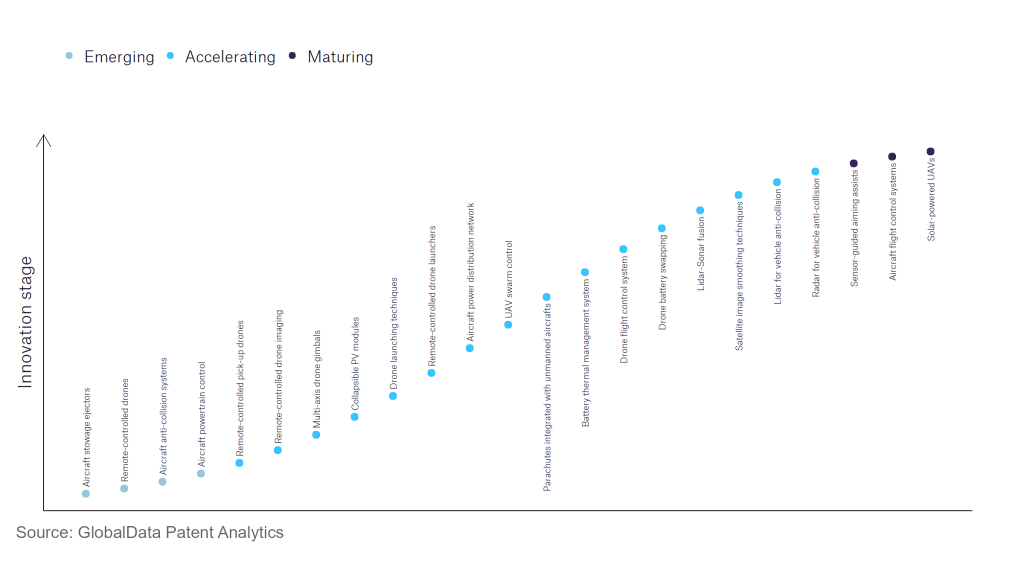The aerospace and defence industry continues to be a hotbed of innovation, with activity driven by the pressing need for modernisation and the growing importance of emerging technologies such as artificial intelligence and unmanned systems. In the last three years alone, there have been over 174,000 patents filed and granted in the aerospace and defence industry, according to GlobalData’s report on Internet of Things in Aerospace, Defence & Security: Solar-powered UAVs. Buy the report here.
However, not all innovations are equal and nor do they follow a constant upward trend. Instead, their evolution takes the form of an S-shaped curve that reflects their typical lifecycle from early emergence to accelerating adoption, before finally stabilising and reaching maturity.
Identifying where a particular innovation is on this journey, especially those that are in the emerging and accelerating stages, is essential for understanding their current level of adoption and the likely future trajectory and impact they will have.
180+ innovations will shape the aerospace and defence industry
According to GlobalData’s Technology Foresights, which plots the S-curve for the aerospace and defence industry using innovation intensity models built on over 262,000 patents, there are 180+ innovation areas that will shape the future of the industry.
Within the emerging innovation stage, aircraft powertrain controls, remote controlled drones, and aircraft anti-collision systems are disruptive technologies that are in the early stages of application and should be tracked closely. UAV swarm control, lidar for vehicle anti-collision, and satellite image smoothing techniques are some of the accelerating innovation areas, where adoption has been steadily increasing.
Innovation S-curve for Internet of Things in the aerospace and defence industry

Solar-powered UAVs is a key innovation area in Internet of Things
Solar-powered UAVs are unmanned platforms which rely solely upon energy from the Sun to power their functions. Solar UAVs are deployed in roles such as communications and persistent ISR.
GlobalData’s analysis also uncovers the companies at the forefront of each innovation area and assesses the potential reach and impact of their patenting activity across different applications and geographies. According to GlobalData, there are 10+ companies, spanning technology vendors, established aerospace and defence companies, and up-and-coming start-ups engaged in the development and application of solar-powered UAVs.
Key players in solar-powered UAVs – a disruptive innovation in the aerospace and defence industry
‘Application diversity’ measures the number of different applications identified for each relevant patent and broadly splits companies into either ‘niche’ or ‘diversified’ innovators.
‘Geographic reach’ refers to the number of different countries each relevant patent is registered in and reflects the breadth of geographic application intended, ranging from ‘global’ to ‘local’.
Patent volumes related to solar-powered UAVs
| Company | Total patents (2021 - 2023) | Premium intelligence on the world's largest companies |
| Boeing | 48 | Unlock Company Profile |
| SoftBank Group | 33 | Unlock Company Profile |
| AeroVironment | 21 | Unlock Company Profile |
| Airbus | 19 | Unlock Company Profile |
| Meta Platforms | 18 | Unlock Company Profile |
| Meditor European Master Fund | 13 | Unlock Company Profile |
| Safran | 11 | Unlock Company Profile |
| MicroLink Devices | 10 | Unlock Company Profile |
| Wing Aviation | 9 | Unlock Company Profile |
| BAE Systems | 9 | Unlock Company Profile |
| XSun | 8 | Unlock Company Profile |
| SkyX | 8 | Unlock Company Profile |
| Alphabet | 8 | Unlock Company Profile |
| Walmart | 8 | Unlock Company Profile |
| Karem Aircraft | 8 | Unlock Company Profile |
| EADS Deutschland | 7 | Unlock Company Profile |
| SZ DJI Technology | 5 | Unlock Company Profile |
| IP Group | 5 | Unlock Company Profile |
Source: GlobalData Patent Analytics
Boeing is one of the leading patent filers in solar-powered UAVs. Through its subsidiary, Aurora Flight Sciences, the company is developing Odysseus. Odysseus is a High Altitude Platform System (HAPS), which is a long endurance high altitude unmanned platform. The platform is intended to provide persistent ISR and communication services to military, civil, and commercial customers. Other key patent filers include AeroVironment, SoftBank and Airbus.
In terms of application diversity, Boeing leads the pack. AeroVironment and Safran stood in second and third positions, respectively. Regarding geographic reach, BAE Systems held the top position, followed by EADS and Safran.
Solar-powered UAVs are a promising new segment of the aerospace market, with applications ranging from persistent ISR in border and maritime patrol, to providing secure communication bubbles in defence contexts, to enhancing broadband in remote areas and in arenas of great demand. As the systems rely upon solar power, they do not need to carry power sources with them, allowing them to stay aloft for very long periods. Groups such as the HAPS Alliance are actively pushing to develop standards and regulations globally to facilitate the rollout of a HAPS market.
To further understand how Internet of Things is disrupting the aerospace and defence industry, access GlobalData’s latest thematic research report on Internet of Military Things.
Data Insights
From

The gold standard of business intelligence.
Blending expert knowledge with cutting-edge technology, GlobalData’s unrivalled proprietary data will enable you to decode what’s happening in your market. You can make better informed decisions and gain a future-proof advantage over your competitors.



